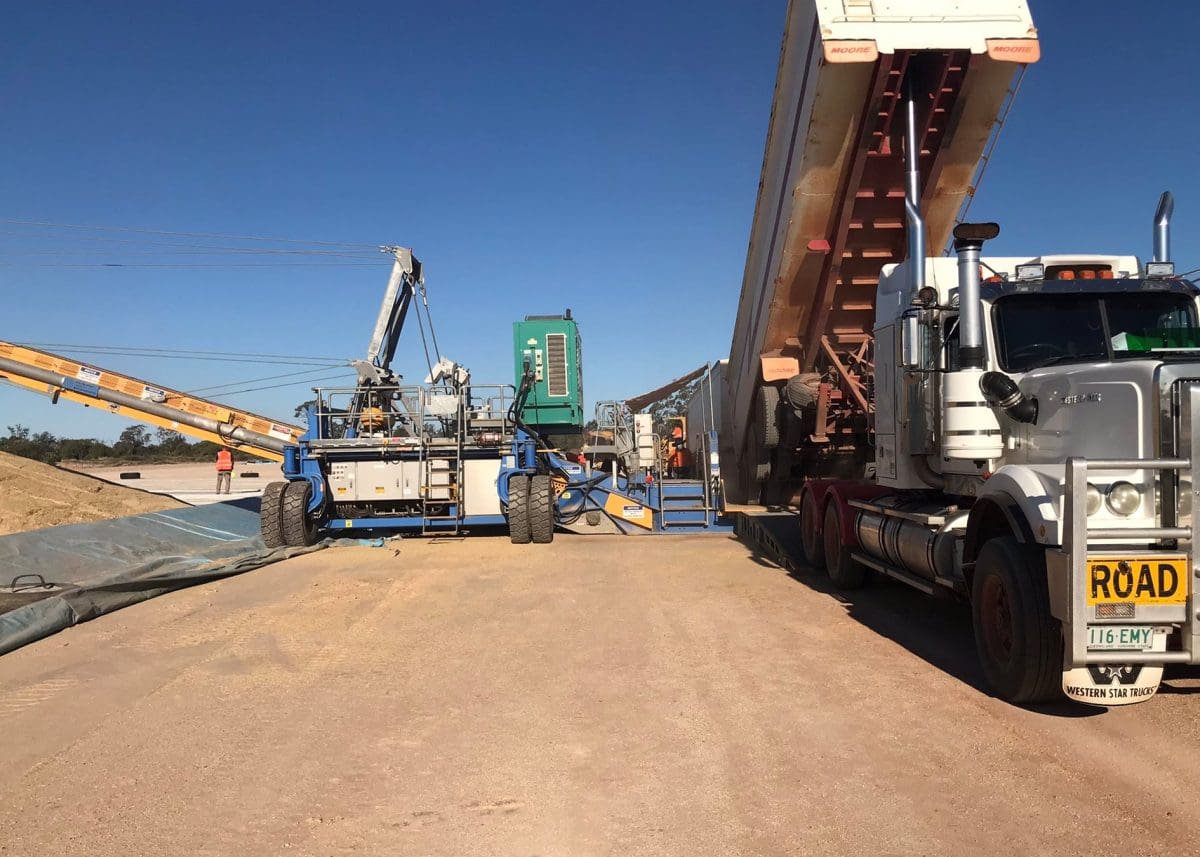
Barley is delivered to GrainCorp’s Talwood site, just north of the NSW-Queensland border. Photo: Dave Beare
NEARBY markets for wheat and barley have risen this week in response to limited selling from growers in the delivered-consumer market.
Accumulation for export continues to dictate values, and up-country and eastern seaboard consumers are lifting their bids prior to the arrival of previously booked new-crop barley and SFW wheat.
Global demand for Australian wheat has blown out the spread between it and barley in the domestic market, and increased barley’s attractiveness for consumers who are expecting to switch to low-protein wheat in coming weeks if the price is right and the volume is there.
| Nearby | New-crop | |
| Barley Downs | $288 up $3 | $303 up $8 |
| Wheat Downs | $375 up $25 | $350 up $18 |
| Sorghum Downs | $308 up $3 | $280 down $5 |
| Barley Melbourne | $295 up $13 | $305 up $15 |
| Wheat Melbourne | $370 up $20 | $365 up $25 |
Table 1: Indicative delivered prices in Australian dollars per tonne.
Queensland harvest hits straps
In the week to 0900 today, scattered storms brought rain and a few patches of hail to some Queensland grain-growing regions, but most received little or no rain.
Among the highest registrations were: Emerald 24mm; Miles 39mm; Macalister 52mm, and Springsure 20mm.
The Queensland barley harvest is well under way, and the wheat harvest is gathering pace in the state’s south-west.
One trade source said trucks to deliver grain to feedlots and other up-country consumers were hard to get because a number of operators are busy picking up on farm and delivering to Brisbane consumers or port terminals.
Because of COVID vaccination requirements for drivers entering Queensland, some operators are not travelling into New South Wales to collect grain.
This is further tightening freight availability.
GrainCorp payment terms at two business days from delivery have made its depots popular among growers, and points to aggressive accumulation for wheat exports.
“Some growers will deliver straight to the GrainCorp depot and get paid in two days.”
Feedlots are posting the strongest prices at some bulk-handling depots in Queensland, as growers look to move some product to local sites ahead of what for many will be their biggest winter-crop harvest since 2016.
Sorghum is still selling to container packers, and to bulk export accumulators.
“The trade is trying to discount new-crop wheat, but their bids aren’t getting a hit.”
Feedlots are winning out on contracts from grower-brokers which call for road-train homes.
“Road trains can’t get into some of the mills on the Inner Downs, but they can access the feedlots on the Western Downs.”
“That’s making it a bit harder for the mills in the towns.”
The NSW harvest is a day or two away from starting following a dry week on the north-west plains, and patchy falls in central and southern regions with Condobolin, on 26mm, and Young, on 27mm, getting the highest in the grainbelt.
Southern offers limited
Many dryland crops in Victoria got a drink in the week to today, with much of the Mallee and Wimmera getting 10-20mm.
Melaluka Trading director Mick Fitzgerald said growers in the south were more likely to lock in forward prices on lower grades.
“The feeling in the south is that with prices at current levels, feed wheat gets well and truly exported into Asia.”
Mr Fitzgerald south the discount on SFW to the base-grade ASW is now around $45 per tonne, out from around $30/t a few weeks ago, as the probability of a large volume of lower-protein wheat across south-eastern Australia increases.
He said this week’s rally may have something to do with some shorts in the market.
“Every October, there are a few DCT traders that need to get covered, and some end users are in there too.”
GeoCommodities broker principal Brad Knight said trade is thin, and consumers and exporters are competing for the higher-protein wheat.
“They’d rather own a bit of it, given the weather that’s around,” Mr Knight said.
Southern domestic consumers are seen as generally fully covered for this month, and hoping the arrival of early new-crop will pressure the delivered November market.
Despite some showers in South Australia in the past week, the state’s biggest bulk-handler, Viterra, yesterday received its first load from the 2021-22 harvest, field peas delivered to its Port Neill site on Eyre Peninsula.
In a statement, Viterra said the 2020-21 shipping season has seen around 5.5 million tonnes of grain exported through its network, and carry-out was low.
“We continue to experience strong demand for grain from our network, which is great news for growers getting ready to deliver to our sites,” Viterra western region manager Nick Pratt said.
“We expect deliveries to slowly start over the coming weeks.”
As with Queensland, delivered-port bids look like they will shape up for South Australian growers this harvest, with Viterra saying it has boosted its service offering by introducing port direct and digital delivery advice.
“Our grower and buyer customers can benefit from up to $11.10 per tonne reduction in receival fees with port direct, which enables buyers to purchase grain directly from growers ahead of when a vessel is booked to load,” Mr Pratt said.
“It provides greater flexibility for growers who prefer to store their grain on farm and deliver their grain directly to port post-harvest.”

HAVE YOUR SAY